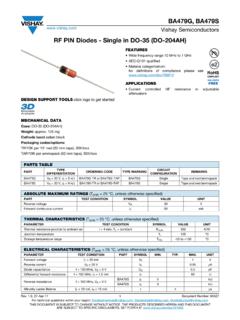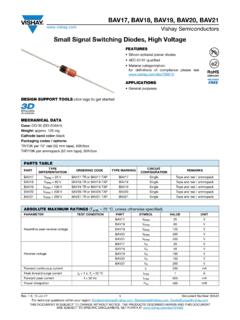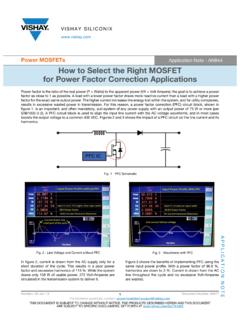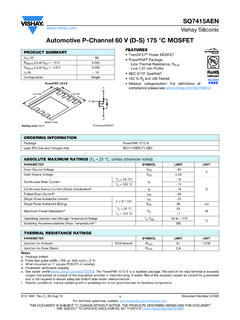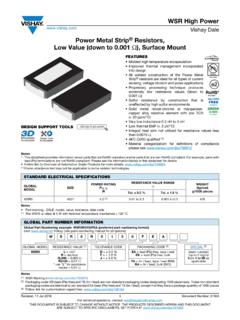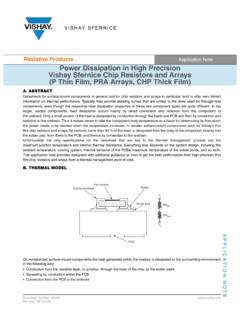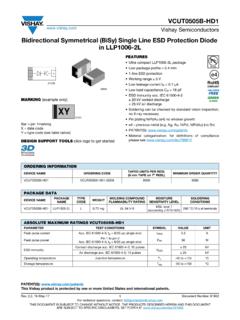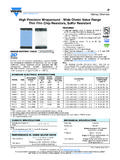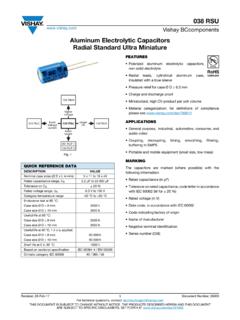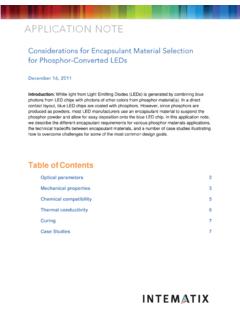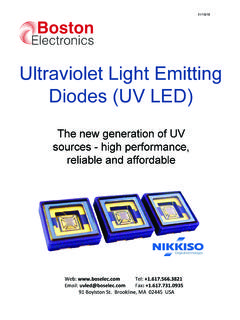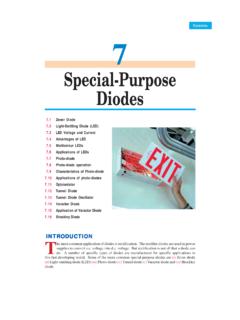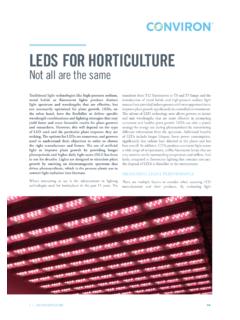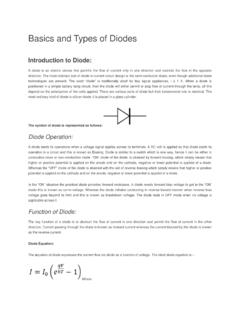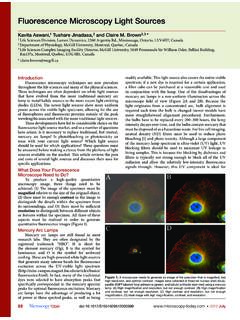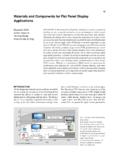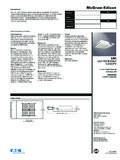Transcription of Eye Safety Risk Assessment of Infrared Emitting …
1 Eye Semiconductors Rev. , 19-Jun-20181 Document Number: 81935 For technical questions, contact: DOCUMENT IS SUBJECT TO CHANGE WITHOUT NOTICE. THE PRODUCTS DESCRIBED HEREIN AND THIS DOCUMENTARE SUBJECT TO SPECIFIC DISCLAIMERS, SET FORTH AT Safety Risk Assessment of Infrared Emitting Diodes According IEC 62471 (based on CIE S009)INTRODUCTIONP roduct Safety legislation ( general product Safety laws as in Europe the low voltage- or machinery directives ) requires conformity with essential requirements , for instance, protection of health and Safety that goods must meet when placed on the market. In this context, compliance with product Safety standards for optical sources, such as the standards IEC 60825-1 and IEC 62471, should provide presumption of conformity with these essential requirements.
2 The compliance is guaranteed when the goods are classified according the standards as safe, expressed as with class 1 or exempt for optical the operating conditions and the optical and mechanical construction of the final goods define the risk. The risk Assessment of LED (1) applications is not directly related to the LED risk Assessment and classification is to be done with the final product, not with the built-in component. In IEC/EN60825-1 that is expressed by Laser products that are sold to other manufacturers for use as components of any system for subsequent sale are not subject to IEC 60825-1, since the final product will itself be subject to this standard . IEC 62471 demands a risk Assessment of the lamp (LED) itself.
3 This may be not sufficient for the application, especially when LED arrays are Assessment FOR LED - APPLICATIONSO ptical sources and optical radiation are covered by different regulative standards. After the latest changes in 2011 the eye Safety standards compiled in the following table are applicable for (1)We are using sometimes in our documentation the abbreviation LED and the word light Emitting diode also for Infrared Emitting diodes (IRED). Whenever the term LED is used, IREDs are included when not otherwise noted. That is common usage but not in agreement with IEC 60050-845 Notes w: for workers environment only(1)IEC/EN 60825-1 (2007-03), DIN EN 60825-1 (2008-05) Safety OF LASER PRODUCTS - Part 1.
4 Equipment classification and requirements (2)IEC 62471 (2006) Photobiological Safety of Lamps and Lamp Systems (3)DIRECTIVE 2006/25/EC OF THE EUROPEAN PARLIAMENT AND OF THE COUNCIL of 5 April 2006 on the minimum health and Safety requirements regarding the exposure of workers to risks arising from physical agents (artificial optical radiation) (19th individual directive within the meaning of article 16(1) of directive 89/391/EEC)EXAMPLE OF APPLICATIONS COVERED BY DIFFERENT OPTICAL RADIATION Safety IEC/EN 60825-1 (2007-03) (1)IEC 62471 (2006) (2)DIRECTIVE 2006/25/EC (3)Fiber optical componentsApplicable for laser sources onlyxwFree air communication IR - remote control (TV, audio, video)IR - communication (IrDA , home)Applicable for laser sources onlyxwLighting (visible and IR), lamps-xwIR - photo flash (traffic enforcement)-xwIR - light barriers-xwLED indicators-xwUV - lamps-xwEye Semiconductors Rev.
5 , 19-Jun-20182 Document Number: 81935 For technical questions, contact: DOCUMENT IS SUBJECT TO CHANGE WITHOUT NOTICE. THE PRODUCTS DESCRIBED HEREIN AND THIS DOCUMENTARE SUBJECT TO SPECIFIC DISCLAIMERS, SET FORTH AT DIFFERENT EYE Safety STANDARDS FOR LEDSThe standard IEC (EN DIN) 60825-1 Safety OF LASER PRODUCTS - Part 1: equipment classification and requirements , is applicable to Safety of laser products Emitting (coherent) laser radiation in the wavelength range 180 nm to 1 mm. In previous editions, LEDs were included in the scope of this standard, and were also included in other parts of the IEC 60825 series, as in IEC 60825 - Part 12, Safety of free space optical communication systems used for transmission of information.
6 Currently the standardization philosophy changed, that with the development of lamp Safety standards, optical radiation Safety of LEDs in general can be more appropriately addressed by lamp Safety standards. IEC 62471 now is to be applied to determine the risk group of an LED or product incorporating one or more 60825-1 does not cover the LEDs Emitting radiation for indication, illumination, lighting, or data transmission , LEDs formerly assessed as class 1 of this standard will be safe also when rated by the new standard ( exempt ).A general standard for the Safety of incoherent sources was already in the past the CIE S009 ( Photobiological Safety of Lamps and Lamp Systems ), which later was published as a new common ISO/IEC standard IEC 62471.
7 This is equivalent but not in all items identical with the European Directive 2006/25/EC with the long title mentioned already European edition of IEC 62471 as EN 62471 was delayed for some time. A new edition of EN 62471 published in the meantime and a technical report published as part 2: Guidance on manufacturing requirements relating to non-laser optical radiation Safety with the new title IEC 62471-2 Ed. 1/TR are available. In Germany this part 2 is published also as technical report as Beiblatt 1 to the basic 62471 according the title Photobiological Safety of Lamps and Lamp Systems lets assume not only to cover the final product as IEC 60825-1 but especially the lamp.
8 The original text, chapter 6 of IEC 62471 says it requires in first order the classification of the lamp: This clause is concerned with lamp classification. However a similar classification system could be applicable to luminaires or other systems containing operating lamps .While in case of incandescent lamps where in most cases just one single conventional lamp (bulb) is used for a luminaire the risk Assessment can refer to the lamp. In case of LEDs with many LEDs combined in one luminaire this may be manufacturers usually do not know the future application and would have to apply any limit set. Thus, since the risk group allocation bases in any case on the most restrictive limits, the result might be inappropriate for the future application or overly restrictive.
9 As the laser Safety standard IEC 60825-1 also IEC 62471 is to be interpreted like The final product will itself be subject to this standard . Only this is strictly in agreement with general product Safety laws ( in Europe the low voltage- or machinery directives ).For instance, the EU product Safety legislation requires conformity with essential requirements , , protection of health and Safety that goods must meet when they are placed on the common market. In this context, compliance with product Safety standards, such as the standards IEC 60825-1 and IEC 62471, should provide presumption of conformity with these essential requirements .CLASSIFICATIONIREDsMost IREDs are Emitting in the 800 nm to 960 nm range.
10 Radiation within these wavelengths causes a thermal retina hazard and thermal injury risk of the cornea and possible delayed effects on the lens of the eye (cataractogenesis). In general the IEC 60825-1 is more restrictive in case of the thermal retinal hazard; the cornea/lens limits with the given conditions can be found only in IEC 62471 and in the European Directive 2006/25 the past IREDs were classified by the simplified method according IEC 60825-1 comparing the maximum intensity emitted under absolute maximum rating conditions. When the intensity was above that limit, the source size had to be taken into account. With that none of the currently available (July/2008) vishay IREDs violate the class 1 limit.
